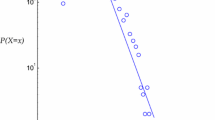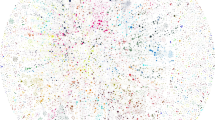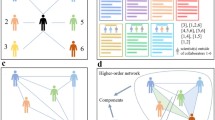Abstract
We present a new tool, Kampal (http://kampal.unizar.es), developed to help to analyze the academic productivity of a research institution from the point of view of Complex Networks. We will focus on two main aspects: paper production and funding by research grants. Thus, we define a network of researchers and define suitable ways of describing their interaction, either by co-publication, project-collaboration, or a combination of both. From the corresponding complex networks, we extract maps which encode in graphical terms the relevant information and numerical parameters which encode the topological properties of the network. Thousands of these maps have been created and allow us to study the similarities and differences of the co-publications and the project-collaboration networks.




















Similar content being viewed by others
References
Abbas, A. M. (2011). Weighted indices for evaluating the quality of research with multiple authorship. Scientometrics, 88(1), 107–131.
Abbasi, A., Altmann, J., & Hwang, J. (2010). Evaluating scholars based on their academic collaboration activities: Two indices, the RC-index and the CC-index, for quantifying collaboration activities of researchers and scientific communities. Scientometrics, 83(1), 1–13.
Abramo, G., D’Angelo, C. A., & Viel, F. (2013). The suitability of h and g indexes for measuring the research performance of institutions. Scientometrics, 97(3), 555–570.
Alonso, S., Cabrerizo, F., Herrera-Viedma, E., & Herrera, F. (2009). h-Index: A review focused in its variants, computation and standardization for different scientific fields. Journal of Informetrics, 3(4), 273–289.
Barrat, A., Barthélemy, M., Pastor-Satorras, R., & Vespignani, A. (2004). The architecture of complex weighted networks. PNAS, 101(11), 3747–3752.
Batista, P., Campiteli, M., Kinouchi, O., & Martinez, A. S. (2006). Is it possible to compare researchers with different scientific interests? Scientometrics, 68(1), 179–189.
Bordons, M., & Barrigón, S. (1992). Bibliometric analysis of publications of Spanish pharmacologists in the SCI (1984–89). Part II. Scientometrics, 25(3), 425–446.
Borgatti, S. P. (2005). Centrality and network flow. Social Networks, 27(1), 55–71.
Borgatti, S. P., & Everett, M. G. (2006). A Graph-theoretic perspective on centrality. Social Networks, 28(4), 466–484.
Brin, S., & Page, L. (1998). The anatomy of a large-scale hypertextual Web search engine. Computer Networks and ISDN Systems, 30(1–7), 107–117.
Brin, S., & Page, L. (2012). Reprint of: The anatomy of a large-scale hypertextual web search engine. Computer Networks, 56(18), 3825–3833.
Cobo, M. J., López-Herrera, A. G., Herrrera-Viedma, E., & Herrera, F. (2011). Science mapping software tools : Review, analysis, and cooperative study among tools. J Am Soc Inf Science Tech, 62(7), 1382–1402.
Costas, R., & Bordons, M. (2007). The h-index: Advantages, limitations and its relation with other bibliometric indicators at the micro level. Journal of Informetrics, 1(3), 193–203.
Csardi, G., & Nepusz, T. (2006). The igraph software package for complex network research. InterJournal, Complex Systems, 1695. http://igraph.org.
Di Caro, L., Cataldi, M., & Schifanella, C. (2012). The d-index: Discovering dependences among scientific collaborators from their bibliographic data records. Scientometrics, 93(3), 583–607.
Egghe, L. (2006). Theory and practise of the g-index. Scientometrics, 69(1), 131–152.
Freeman, L. C. (1979). Centrality in social networks conceptual clarification. Social Networks, 1(3), 215–239.
Fruchterman, T. M. J., & Reingold, E. M. (1991). Graph drawing by force-directed placement. Software: Practice and Experience, 21(11), 1129–1164.
Grauwin, S., & Jensen, P. (2011). Mapping scientific institutions. Scientometrics, 89(3), 943–954.
Hirsch, J. (2005). An index to quantify an individual’s scientific research output. PNAS, 102(46), 16569–16572.
Iglesias, J. E., & Pecharromán, C. (2007). Scaling the h-index for different scientific ISI fields. Scientometrics, 73(3), 303–320.
Ladyman, J., Lambert, J., & Wiesner, K. (2013). What is a complex system? European Journal for Philosophy of Science, 3(1), 33–67.
Mryglod, O., Kenna, R., Holovatch, Y., & Berche, B. (2013). Comparison of a citation-based indicator and peer review for absolute and specific measures of research-group excellence. Scientometrics, 97(3), 767–777.
Newman, M. E. J. (2001a). Scientific collaboration networks. I: Network construction and fundamental results. Physical Review E, 64(1), 016,131.
Newman, M. E. J. (2001b). The structure of scientific collaboration networks. PNAS, 98(2), 9–404.
Newman, M. E. J. (2001c). Scientific collaboration networks, II: Shortest paths, weighted networks, and centrality. Physical Review E, 64(1), 016,132.
Newman, M. E. J. (2006). Finding community structure in networks using the eigenvectors of matrices. Physical Review E, 74(3), 036,104.
Opsahl, T., Agneessens, F., & Skvoretz, J. (2010). Node centrality in weighted networks: Generalizing degree and shortest paths. Social Networks, 32(3), 245–251.
Pons, P., & Latapy, M. (2006). Computing communities in large networks using random walks. Journal of Graph Algorithms and Applications, 10(2), 191–218.
Price, D. (1965). Networks of scientific papers. Science, 149(3683), 510–515.
Rafols, I., Porter, A. L., & Leydesdorff, L. (2010). Science overlay maps: A new tool for research policy and library management. Journal of Ameican Society for Information Science and Technology, 61(9), 1871–1887.
Ruocco, G., & Daraio, C. (2013). An empirical approach to compare the performance of heterogeneous academic fields. Scientometrics, 97(3), 601–625.
Salton, G., & McGill, M. J. (1987). Introduction to modern information retrieval. New York: McGraw-Hill.
Strang, G. (2005). Linear algebra and its applications (4th ed.). Boston, MA: Cengage Learning.
Torrisi, B. (2014). A multidimensional approach to academic productivity. Scientometrics, 99, 755–783.
Van Eck, N. J., & Waltman, L. (2009). How to normalize cooccurende data? An analysis of some well-known similarity measures. Journal of the American Society for Information Science and Technology, 60(8), 1635–1651.
Wallace, D. L. (1983). Comment to “A method for comparing two hierarchical clusterings”. Journal of the American Statistical Association, 78(383), 569–576.
Author information
Authors and Affiliations
Corresponding author
Rights and permissions
About this article
Cite this article
Álvarez, R., Cahué, E., Clemente-Gallardo, J. et al. Analysis of academic productivity based on Complex Networks. Scientometrics 104, 651–672 (2015). https://doi.org/10.1007/s11192-015-1627-1
Received:
Published:
Issue Date:
DOI: https://doi.org/10.1007/s11192-015-1627-1




